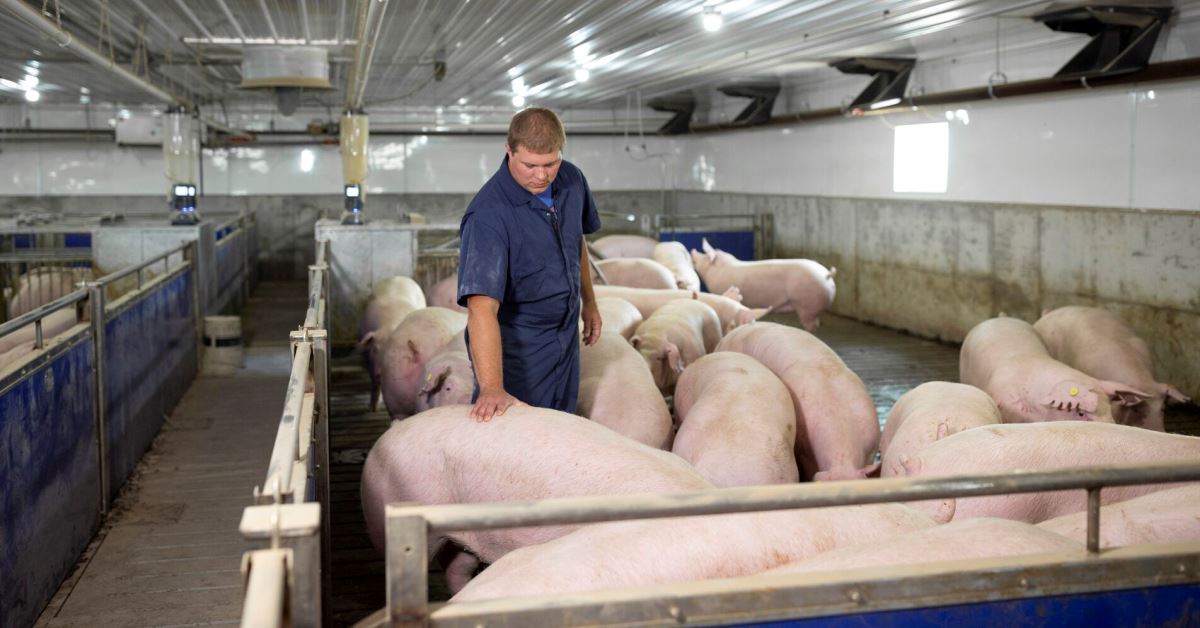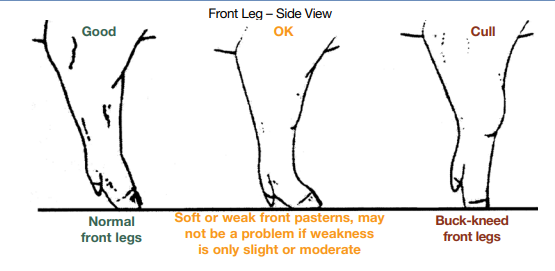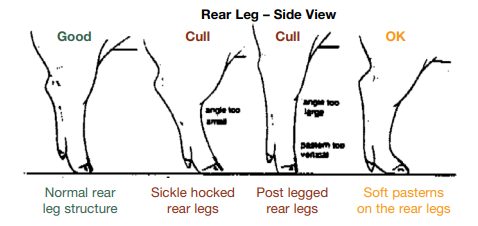
Replacement gilts are essential for maintaining the productivity of the sow herd. Many producers experience a high loss of sows from their herd, which increases the number of replacement gilts that are needed each year as a result. However, having replacement gilts with less-than-optimal qualities increases the likelihood of those animals not making it into the herd, which compounds the need for more replacement animals. Whether you raise your own replacement gilts or purchase them instead, taking into consideration a few important attributes regarding gilt selection and management can improve their productivity and longevity within the herd.
Things to consider when selecting a replacement gilt
The most common reasons for culling gilts and sows within a herd can be attributed to reproductive failure, feet and leg abnormalities, and reproductive unsoundness (e.g., underlines, external genitalia, etc.). Identifying and eliminating replacement gilts with one or more of these deficiencies before they enter the breeding herd is key to lowering breeding herd replacement rates and/or mortality rates. Whether a producer purchases replacement gilts or produces their own internally, identifying these problems ahead of time minimizes the herd’s non-productive days and, in turn, positively impacts the number of pigs weaned per sow each year.
1. Feet and leg soundness
Feet and leg abnormalities represent the second-most-common reason for sows leaving the breeding herd at an early parity. An ideal replacement gilt should have good cushion and flexion in her joints, toes that are big and evenly sized, and large feet. Their feet should be examined for cracked hooves, foot pad abrasions or other injuries. Although not genetically related, feet and leg injuries can be costly. If possible, treat any animals with foot or leg injuries and monitor them to see if these injuries improve. If recovery is not an option, use caution if these animals are retained in the breeding herd.
Soft or weak front pasterns are known to positively impact sow longevity. This is due to the result of the shock-absorbing effect that this type of foot provides to the gilt. Straight pasterns on the rear legs are not ideal, as they can negatively impact the age at first farrowing, as well as the farrowing interval, the total number born and piglet mortality from birth to weaning. Avoid selecting gilts that are splay-footed, pigeon-toed or cow-hocked. Additionally, animals that show signs of being buck-kneed often have a difficult time walking and getting up and down, particularly when housed in a crated environment. This trait is genetically influenced and can be passed on to their offspring.


Pictures taken from the Replacement Gilt Evaluation Pocket Guide, Pork Checkoff, 2010.
Other factors affecting soundness include diseases, nutritional deficiencies and floor surfaces. Disease organisms — such as Streptococcus, Mycoplasma and Actinobacillus pleuropneumonia — can lead to arthritic conditions within the joints of gilts. Nutritional deficiencies and imbalances of calcium, phosphorus and other nutrients can influence bone mineralization and may cause locomotion problems due to the excessive depletion of mineral stores during lactation periods. Floor surfaces that are rough, slats with sharp edges and smooth, wet floors can also create soundness issues by negatively impacting the animals’ hoof and leg growth.
2. Underlines
The underline of the gilt is also an important factor to consider when selecting replacement gilts. The number, spacing and location of functional teats are crucial to successfully raising piglets. An ideal underline should have seven or more functional nipples on each side. The nipples should be well-spaced and well-developed. Blind or pin nipples should not be present. The ideal nipple spacing and location are depicted below.

Pictures taken from the Replacement Gilt Evaluation Pocket Guide, Pork Checkoff, 2010.
3. External genitalia
External genitalia should also be evaluated on all replacement gilt candidates. An example of a well-developed vulva is pictured below.

Gilts that have an infantile vulva (as shown in image 1 below) frequently have an underdeveloped reproductive tract. A small vulva (as shown in image 2 below) should also be avoided, as this may lead to difficulty mating (particularly in a natural mating setting), as well as farrowing difficulties down the line. Tipped vulvas (as shown in image 3 below) are also not ideal, as they fail to completely drain urine and may contribute to increased incidences of metritis and cystitis. Injured vulvas should also be avoided, as they may impair mating, and once any injuries have healed, any scar tissue they leave behind could cause farrowing difficulties.

Pictures taken from the Replacement Gilt Evaluation Pocket Guide, Pork Checkoff, 2010.
Management strategies for maximizing replacement gilt success
1. Boar exposure
Properly exposing boars to young gilts can help producers identify fertile females; at the same time, non-fertile females will also be identified as quickly as possible and can be removed from the herd to minimize feed costs and losses in market value due to excess weight.
Stimulating heat involves exposing gilts directly to mature boars. The boar provides two principal components: physical touch and smell (or pheromones) that can stimulate the onset and expression of estrus in females. The stimuli the boar provides encourage the greatest proportion of gilts to come into estrus in the first three weeks following boar exposure. Gilts should not be exposed to a boar for extended periods of time because they can become habituated to the boar’s presence, which can result in a decrease in the estrus detection rate and in the observed duration of estrus.
- Guidelines for boar exposure
- Gilts should be 160–180 days of age at exposure.
- Boars must be more than 10 months old.
- Full physical contact is ideal.
- Exposure for a minimum of 15 minutes a day is recommended.
- Gilts should be 160–180 days of age at exposure.
The behavioral expression of heat is displayed when the gilt’s ovary follicles mature and release estrogen. Signs of heat in gilts who are in the presence of a boar can include pricked ears, standing with an arched back, glazed eyes, and standing rigid if mounted or if back pressure is applied. Not all gilts in heat will display all of these signs. The intensity and time it takes for the female to stand when introduced to a boar depends on their stage of estrus. The quickest and strongest signs of heat will manifest during mid-estrus compared to just after the start or before the end of estrus. Gilts also express estrus most reliably when detection is performed at the same time every day and will express it best in the morning.
2. Litter strategies
According to Dr. Tim Safranski of the University of Missouri, research has shown that the way young gilts are managed in the litters they were born into can affect their long-term productivity. For producers raising their own replacement gilts, if possible, it is important to reduce the litter size of potential gilts to six or seven piglets within 24 hours of their birth to maximize their growth and reproductive performance. Gilts raised in smaller litters have displayed increased gilt longevity (at least through parity two) and lifetime reproductive performance. This has also been shown to increase their ovulation rate and embryo survival. Females from smaller litters also reach sexual maturity earlier than gilts from larger litters. Dr. Safranski also advises producers to choose gilts with greater birth weights, which has been shown to positively influence their vaginal length, follicular dynamics and ovarian weight.
When possible, select gilts from sows in their third parity or greater. This allows producers to assess the fertility of the dam and increases the likelihood that these replacement gilts received the highest-quality colostrum.
3. Age at puberty/breeding/farrowing
The expression of puberty is a critical point in the life of a replacement gilt, as it identifies the gilt as potentially fertile and sets her up for future breeding. Early-puberty gilts have been shown to display greater lifetime productivity, and the age at which gilts reach puberty will also influence their age at first mating and farrowing.
Listed below are guidelines for managing replacement gilts. Producers are encouraged to consult with their genetic suppliers for specific recommendations.
- Target to breed at second or third estrus (i.e., 300–320 lbs.)
- Age at first mating: ~200–225 days of age
- Age at first farrowing: ~330 days of age
4. Nutritional strategies
Developing gilts should be fed a higher level of vitamins and minerals in the later phases than market animals. A grow-finish premix is adequate for developing gilts (up to 150 lbs.), as it meets their calcium and phosphorus requirements and saves on costs when gilts are housed with the general population. Providing a sow premix is recommended for developing gilts after 150–180 lbs. for the final development of the reproductive system, as well as bone and mammary development, breeding and leg structure, etc.
A fiber source, like soy hulls or wheat midds, can be utilized for gilts on full feed to dilute the energy level, which assists in body condition management and provides satiety. This also helps producers slow growth slightly, preventing foot and leg problems and excess fat gain.
A gilt nutrition program should supply sufficient nutrients to meet the gilt’s needs for maintenance while also supporting growth in both the gilt and her litter. Adjust the feed to the gilt’s body condition. Gilts that are too thin or too fat will have delayed wean-to-estrus periods. On the other hand, fast-growing gilts are negatively correlated with immature reproductive system development, decreasing their reproductive lifetime.
It is crucial to check your feed for mycotoxins, as they have the potential to disrupt reproduction. If you’re raising your own gilts, mycotoxins can pass through and contaminate the milk, impacting the mammary gland and reproductive tract development of potential replacement gilts.
Conclusion
When choosing a replacement gilt, it’s important to make selections based on physical traits such as foot and leg soundness, which are important for longevity. Selections should also take underlines and external genitalia into consideration, as they contribute to gilts’ reproductive productivity. Instituting excellent management practices and providing proper nutrition will support the successful process of introducing highly productive replacement gilts into the herd. Additionally, producers should work with their herd veterinarian to develop a herd health plan and vaccine program that fits their operation.
Dr. Safranski stresses that the overall goal is to have an adequate number of replacement gilts to incorporate into the herd. The specific number needed is based on annual culling rates and also takes into consideration that not all of the gilts that are selected will make it into the herd, due to physical shortcomings, health challenges and reproductive inefficiencies. It takes roughly three parities for a gilt to pay for herself. Implementing the selection and management strategies outlined above will improve the success rate of introducing gilts to the breeding herd, which will positively impact the operation’s bottom line.
Additional information on gilt development can be found in Hubbard Feed’s Breeding Herd Management Guide, which is available on our website. Contact your Hubbard Feeds representative if you are interested in a more detailed evaluation of your replacement gilt program.
- Log in to post comments
